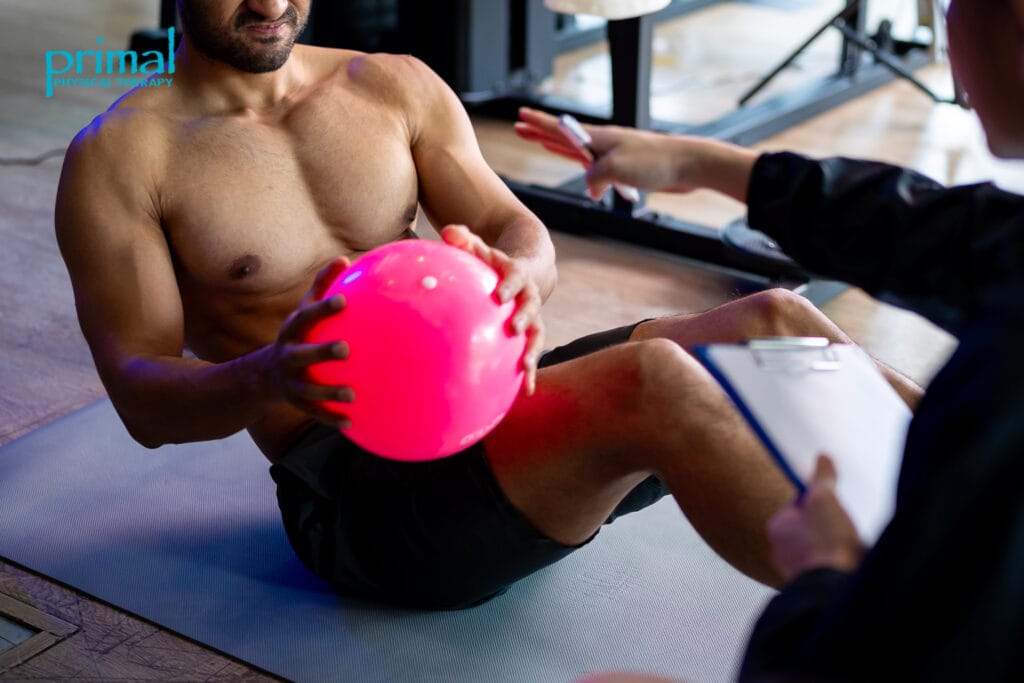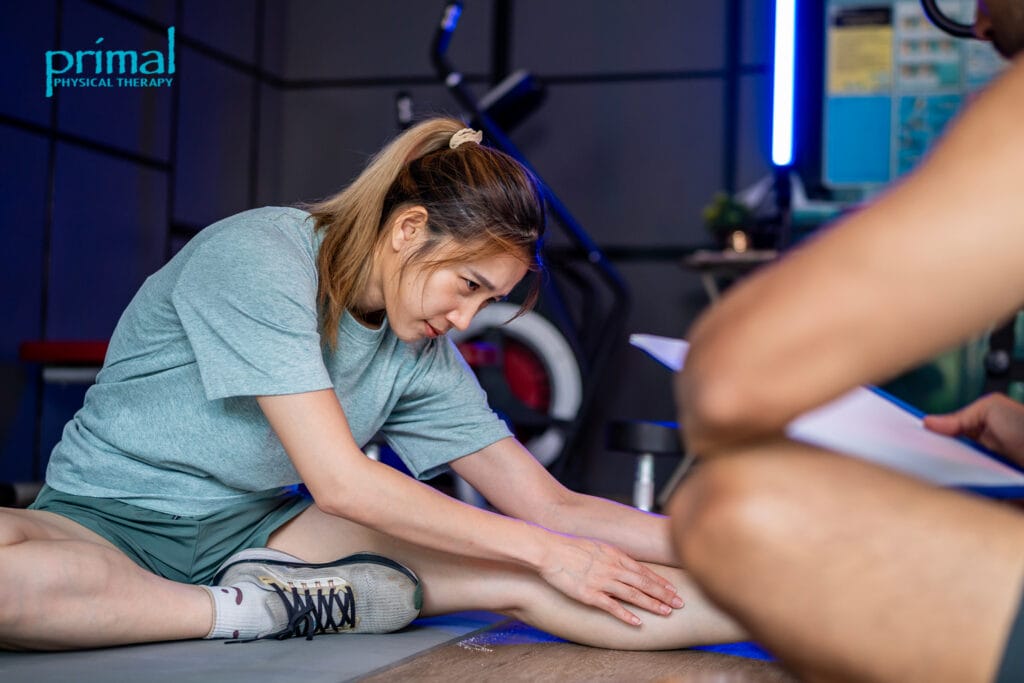Fact Checked By: Dr. JJ Thomas, DPT, CMTPT, FDNS
“You have to train your mind like you train your body” – Gary Mack
Being an athlete is not only a physical feat, but also a mental one. Where the brain and body meet is what we call neuromuscular re-education. Our body is a fully efficient system that won’t let any resource go to waste. During an injury or a surgery, we lose connection of our brain to our body because we aren’t using a limb, body part, or muscle group. Rehabilitation and neuromuscular reeducation is the reconnection of our body to our mind after trauma, injury, or even just from sitting down writing a blog for too long.
Understanding the Science Behind Neuromuscular Re-Education
Neuromuscular reeducation is defined as different clinical techniques used to restore normal body movement patterns designed to communicate the brain, nerves, and muscles. There are many tools and avenues to facilitate normal body movement patterns, all with the same goal in mind of reconnecting our brain to our body. This works through a principle in neuroscience known as neuroplasticity.
Neuroplasticity is an intrinsic neurophysiological feature that occurs dynamically throughout life and can be defined as a morphological or functional change in neuronal properties, such as strength of internal connections, altered representational patterns or a reorganization of neuronal territories1. This is crucial to any event in our lives as humans. Our brains are so dynamic and ever changing that we have the capacity to change our chemistry throughout our lifetimes.
Above is a visual illustration of the connection between how we sense (feel) things and how they are related to our muscular system. As we perceive temperature, proprioception, or pain along our bodies, that information is sent up to the brain which corresponds to an output or response from our motor system. If we touch water that is too hot, our brain will reflexively pull our hand away from that water to protect us from harm. Same goes for any type of injury; we get a stress shield to protect us from further injuring any tissue as a means to protect our body from further harm. As we go through the cascade of healing an injury, this disruption needs to be rewritten through the means of neuroplasticity and neuromuscular reeducation to return to normal movement patterns.
The Assessment Process for Identifying Neuromuscular Deficits
From a research perspective, there are several tools used to assess motor output and neuromuscular dysfunction including force plates, motion capture devices, isokinetic machinery that measures peak power of a muscle group. This is difficult to mimic clinically as these devices are not always readily available. We have written about our running gait analysis that uses motion capture that some clinics may have access to, but most do not have access to such equipment.
We as physical therapists are movement specialists, and have gone through rigorous training to be able to understand efficiencies of the human body. With repetition and intention, a lot of physical therapists are able to pick up on motor dysfunctions with observation through movement screening. Here at Primal, we often start out with the SFMA screening tools to observe the three dimensional movements of all joints and how they move functionally in space. This tool allows us to connect how one dysfunction may be contributing or being caused by another somewhere else.
Key components in the athlete correspond to power output and speed (depending on sport). As we speed up a movement pattern, it becomes more apparent and easier to find poor movement strategies. Minute changes in motion or initiation can lead to a significant improvement in power and speed.
Core Neuromuscular Re-Education Techniques for Sports Rehabilitation

There are several different proprioceptive training methodologies, but the one that started the rest is called PNF. PNF stands for Proprioceptive Neuromuscular Facilitation which encompasses appropriate input required to affect this brain-body connection. Proprioceptive neuromuscular facilitation techniques incorporate movement in the three planes of the body. With the current emphasis on multi-planar exercises in treating athletic injuries, PNF procedures provide an effective means for delivering this type of approach3.
From this solid foundation of our understanding of PNF, we have added more tools to progress from this foundational knowledge. Progression of balance and stability exercises with use of different surfaces, varying angles and degrees of forces on the body, and progressive loading with alteration to vision, base of support, or forces encourage the adaptation of our nervous system to prepare for any given external force. Most sports are contact sports and our body has a natural feed-forward mechanism that needs to be intact and ready no matter how we use it on the field.
To accelerate this even further, there are biofeedback mechanisms that can read how much we change our base of support varying on forces or different surfaces. Maintaining a greater dynamic base of support allows for control in a greater area.
One of the key principles of PNF is the importance of appropriate input to achieve a desired response (motor output) from the brain. This comes down to tactile cues and providing appropriate hand placement and sensory input on skin to help facilitate appropriate motor output. Just like the photo shown previously, our skin receptors are responsible for how the brain chooses to respond to a stimulus. This is similar to how cold/heat work; ice can be facilitating to tissue for short periods while heat can be inhibitory.
Outside of tactile cues, we can also use visual or verbal cueing to facilitate motor patterns. Visual cues can be as simple as using your eyes to follow a movement arc/pattern or use of a mirror to access mirror neurons for further neuroplastic changes. Verbal cues may be more necessary in the beginning training, but are rarely needed later on in motor learning.
Sport-Specific Applications of Neuromuscular Training

As mentioned earlier, sports are three-dimensional and difficult to train for given the “moment to moment” adaptation to how we respond. This is tailored separately depending on sport. Sports like running and cycling have one primary direction of motor control while sports like golf, baseball swinging, and tennis have a lot of rotational directionality to them. Sports like basketball, football, soccer, and swimming all have a combination of movement patterns requiring different training and different demands dependent on sport.
Each movement pattern and movement strategy have different demands and training that needs to occur. For example, rehab for a quarterback will require a lot of open chain stability and power output for throwing compared to a lineman who will require training in their stance preparing for an oncoming force. It is the job of the physical therapist to train and prepare our athletes for their sport specific demands.
Integration with Traditional Rehabilitation Approaches
There are some foundational requirements to best incorporate neuromuscular training into practice. While most forms of rehabilitation have some form of neuromuscular reeducation to them, knowing where and when to incorporate into sports rehabilitation takes practice. Strengthening and flexibility training are worked alongside or prior to engaging in challenging dynamic neuromuscular reeducation. If I do not have strength or range of motion to move from, it is difficult to reeducate within an arc of motion.
It is recommended to apply neuromuscular components throughout the recovery process. For example, during a post op ACL injury when movement is little and strength hasn’t been established yet, we can encourage appropriate recruitment and neuromuscular reeducation through the small amount of strength and range they do have available at that time. Personally, any time we acquire a new range of motion, the brain needs to learn that new motion is available. Thus always incorporating neuromuscular reeducation after mobilization is encouraged.
Most sports teams have an entire personnel with strength coaches and athletic trainers that are part of the recovery and rehabilitation team. Collaborating and collectively working to break down specific needs for that athlete or position can help encourage motor learning and remapping of the motor cortex together. This often includes breaking down motions and movement patterns to their basics and build from a solid foundation.
Success Story
Recently, I had a collegiate baseball player with a chronic adductor (commonly known as groin) strain enter our clinic. This athlete had to completely change his pitch to avoid further pain and injury to his adductor which resulted in decreasing his avg pitch speed to 88 mph from where he had been prior to injury at 90-92 mph. Upon evaluation, found biomechanical dysfunction associated with his thoracolumbar junction and pelvic girdle. Both were suspected to be limiting the recovery and output of their adductor during the follow through of their pitch. It took two visits to address the pelvic girdle and thoracolumbar movement dysfunctions through mobilization/manipulation, adductor and quadratus lumborum tension through dry needling, and following with heavy neuromuscular reeducation to their core and adductor to get them back to their average 90-92 mph pitches.
Not all stories can be this dramatic in change, but goes to show the power of an eclectic approach affecting structure, function, and control with appropriate interventions. Having learned from more challenging cases, the order of operations of interventions can be powerful. It can be frustrating if we try to incorporate neuromuscular reeducation too quickly or without proper structural biomechanics first.
Conclusion
Neuromuscular reeducation is overall the key to how athletes are able to perform at the amazing levels they are able to. Neuromuscular reeducation is important for a recovering athlete, a long time athlete, and any athlete trying to improve efficiency at their already high level of competitiveness. Its dynamic capabilities through all sports and capacity for neuroplastic changes in the brain make it applicable to all sports and all athletes.
Neuromuscular reeducation is just a piece of a larger puzzle. When used effectively with incorporation of eclectic treatment models can take our athletes and practitioners to a new level of quality care. We as physical therapists need to continue to hone our skill sets to facilitate safe advancements in power, speed, and overall performance.
Whether you’re an athlete that is recovering from an injury, seeking to improve performance, or wanting to maintain a level of competitiveness and strength in your sport over decades, having a PT at Primal will help achieve any goal.
References:
1.Boudreau SA, Farina D, Falla D. The role of motor learning and neuroplasticity in designing rehabilitation approaches for musculoskeletal pain disorders. Manual Therapy. 2010;15(5):410-414. doi:https://doi.org/10.1016/j.math.2010.05.008
2.Introduction to Sensory and Motor Pathways | Anatomy. courses.lumenlearning.com. https://courses.lumenlearning.com/suny-dutchess-anatomy-physiology/chapter/the-function-of-nervous-tissue/
3.Surburg P, Schrader J. Proprioceptive Neuromuscular Facilitation Techniques in Sports Medicine: A Reassessment. 1997;34(1). Accessed April 19, 2025. https://pmc.ncbi.nlm.nih.gov/articles/PMC1319233/pdf/jathtrain00013-0036.pdf
4.ZECH A, HÜBSCHER M, VOGT L, BANZER W, HÄNSEL F, PFEIFER K. Neuromuscular Training for Rehabilitation of Sports Injuries. Medicine & Science in Sports & Exercise. 2009;41(10):1831-1841. doi:https://doi.org/10.1249/mss.0b013e3181a3cf0d
5.Coito J, Oliveira R, Melo F. Effects of a Neuromotor Reeducation Program on Postural Control and Musculoskeletal Injury Incidence of Amateur Football Players. 2016;(2). https://www.researchgate.net/publication/310800582_Effects_of_a_Neuromotor_Reeducation_Program_on_Postural_Control_and_Musculoskeletal_Injury_Incidence_of_Amateur_Football_Players
6.Judd DL, Winters JD, Stevens-Lapsley JE, Christiansen CL. Effects of neuromuscular reeducation on hip mechanics and functional performance in patients after total hip arthroplasty: A case series. Clinical Biomechanics. 2016;32:49-55. doi:https://doi.org/10.1016/j.clinbiomech.2015.12.008